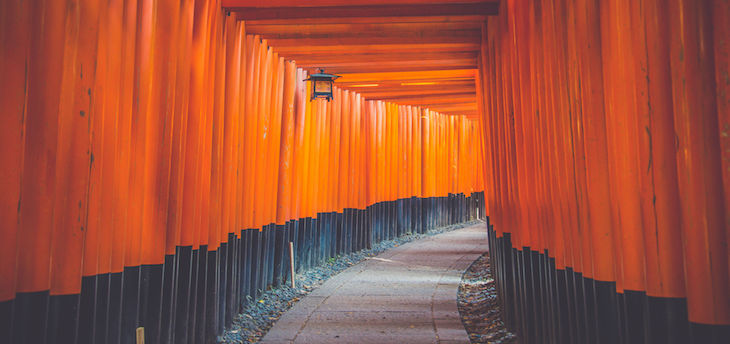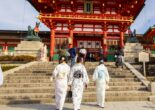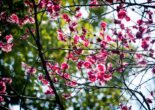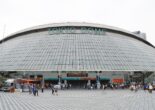
Kyoto – Some Useful Tips for a Pleasant Stay in the old Capital
Kyoto has experienced a surge of tourists in the last years and this comes as no surprise. Being the capital for over 1,000 years, Kyoto is home to countless cultural heritage sites worth exploring. But with roughly 57 million tourists (both foreign and national) visiting Kyoto alone in 2015, it is hard to imagine that you can still feel some of that traditional atmosphere Kyoto is so famous for. Even more, residents voice an increasing concern about the rising numbers of tourists and their lack of respect for the local community.
Kyoto is a true gem, but as it is with anything valuable, we should treat the city, its residents and heritage sites with respect. This will not only benefit the city but in the end, the tourists themselves because they will be welcomed with greater hospitality. I only spent a year in Kyoto as an exchange student but I learned the following things:
1) Avoid the peak times for tourists
You thought, the Tokyo Yamanote Line is packed during rush hour? Then you haven’t been to Kyoto during New Year. The whole inner city and all the tourist sites are basically one rush hour Yamanote train you cannot escape from. If you have the chance to be flexible in your itinerary, try to avoid those times when everyone has holidays. Because you have to keep in mind that nearly every person on this planet has New Year holidays and although not everyone will go to Kyoto, millions of people will. The same goes for typical Japanese holidays such as Golden Week (beginning of May), Obon (middle of August), and the seasons for cherry blossoms as well as fall foliage. But of course, everyone wants to go to Kyoto for the breathtaking cherry blossoms and fall foliage. Try to avoid weekends, especially the ones with public holidays on Fridays and Mondays, as many Japanese are also traveling to Kyoto around that time. In general, you can avoid a lot of people by going to the more famous sights such as the Golden Pavilion by going in the morning on a weekday. A lot of the temples close around 4 or 5pm, so it’s best to rise early.
A little tip: day-trip tourists often leave around 5pm-ish. Shrine grounds can normally be entered even after temples and museums have closed their doors. Wandering through shrine grounds when it’s dark is really something. For example, the Yasaka Jinja in Gion is often beautifully illuminated in the night.
Do’s
Avoid typical holidays and instead try to visit Kyoto during the week
Explore Kyoto by night
Recommended “nighttime walk”
Kamogawa River – Gion – Yasaka Jinja – Nene no Michi
From Yasaka Jinja along the Nene no Michi you will pass by many temples, you probably won’t be able to enter any more because it’s past 5pm. But the atmosphere is wonderful as many tourists will have left the area. Nene no Michi is the street going up to Kiyomizu Dera and alongside this street you will find plenty of souvenir shops attracting tourists. During the day it’s hard to have a pleasant stroll here but as most people come for the shops and the Kiyomizu temple, you are able to enjoy the old wooden houses and narrow side streets when there are less people after 6pm.
The Fushimi Inari Shrine is famous for its red toriis but the graveyards that are scattered along the way are worth a visit as well
2) Be respectful
When abroad, many people tend to lose their good manners – maybe without realizing it. Japanese people are known for being hospitable, polite and friendly but even they reach their limits when encountering ill-mannered tourists. Kyoto has a population of 1.5 mio people but when you walk the little side streets, you might feel like you are in a small town. Gion still has its share of local residents, so try to keep that in mind when you walk the neighborhood during the night. Many complaints have been made because of noisy tourists waking up residents. And yes, chances of seeing a Maiko are actually pretty high during morning or evening hours but don’t shove your camera in her face. She is not Mickey Mouse and Gion is not Disneyland. The Maiko is trying to keep up with her busy schedule and probably on her way to work, so stalking her with a DSLR and tele lens is disrespectful. If you want to take a photo with her, ask her politely. Same rules apply for other (photogenic) local residents. Old granny sweeping the front steps of her old Machiya house? So authentic! But ask her first if she wants to be photographed.
Another point is littering. You might have noticed the massive lack of garbage bins which is inconvenient to most tourists but it doesn’t mean garbage can be left everywhere. If all else fails, there is always the convenience store garbage bin.
Drinking in public is allowed in Japan but don’t do it on temple or shrine grounds. You also wouldn’t go to a church and get drunk inside.
3) Walk and bike a lot
The inner city center of Kyoto is really not that big and distances can be easily walked. Navigation within the city is remarkably easy as the ancient city planners designed the city layout like a chessboard. The east and west part are separated by the Kamogawa River which runs from north to south and is a popular hangout spot for people.
Moreover, many of the hidden temples and shrines can only be explored by walking and simply “getting lost”, because no matter which corner you turn, there will always be something historical.
Rental bike shops (few links)
https://www.kyotostation.com/bicycle-rental-in-kyoto/
https://kyoto-option.com/english/
http://www.kctp.net/pc/en/
The Kamo River – Kamogawa – is often filled with young people that need a bit of fresh breeze from the humid summers. The east side of the Kamogawa is less crowded and thus perfect for you to ride your bike!
4) Check the “Must-Sees” but try to leave the beaten path
Even before going to Kyoto, you surely already have a few things in mind you definitely have to see.
High on this list are usually:
Kinkakuji – aka The Golden Pavilion
Ryoanji – famous for its Stone Garden
Kiyomozudera – large wooden terrace with a beautiful view over Kyoto
Ginkakuji – aka The Silver Pavilion
Fushimi Inari Taisha – with hundreds of thousand red Torii gates
Arashiyama – with its bamboo forest
Gion – with the hope of spotting a Maiko
Those are all great sights but be prepared for the crowds. Some of my most favourite places in Kyoto I encountered by walking a different street or by just “continue walking”.
One such place I dearly love is the Philosopher’s Path or Tetsugaku no Michi. The path is extremely popular when cherry blossoms start blooming as dozens of cherry blossom trees are lined along the canal. Many people combine the pleasant stroll with a visit to the Silver Pavilion but not all actually walk the whole Philosopher’s Path till the end until Zenrinji and Nanzenji Temple. A big loss, because many smaller temples are scattered along the path that are rarely visited by tourists. They are hidden behind trees and you may find yourself completely alone in one of them. The Nanzenji at the end of the path is one of my favourites. The temple grounds are spacious, gardens and temples are beautiful and the aqueduct ruins add to the special atmosphere. From the Nanzenji you can pass by the Murin-an Villa that is home to a beautiful Japanese Garden and then via the Niomon Dori you will see the Heian Jingu with the biggest red Torii in Japan before reaching Sanjo and the good old Kamogawa River.
Are you in Kyoto when it’s all sunny and hot? Then head to the Kamogawa Delta. Many tourists take a break at the Kamogawa River close to Sanjo and Shijo but not many make it all the way up to the delta, where the Kamogawa River and the Takano River meet. There is a little park and young and old will hop over the turtle stones from one river side to the other. Or just sit down on one of the large stones and cool your feet in the cold water. If you are lucky, you will spot a (not dangerous) water snake. If you are super, unbelievably lucky, you might spot a Japanese giant salamander. They tend to live in the wilder areas of the Kamogawa up north but sometimes they are even spotted in the southern part. Head north from the delta and you will reach the elegantly secluded Shimogamo Shrine. A little nice forest with 600 years old trees surrounding the ancient shrine is a welcoming break from the masses.
Byodoin – everyone has used the ten yen coin with the famous temple on it but few actually go to Uji to see the beautiful temple with their own eyes
5) Drink and eat as much Matcha as you can but don’t forget Yatsuhashi
No Kyoto visit is complete without a fair amount of Matcha. Matcha can be drunk in its traditional form by attending a tea ceremony or by simple having a cup of Matcha at a tea house. But don’t forget all these incredible Matcha sweets and desserts! The neighboring city Uji is famed for its green tea quality, so you will find plenty of sweets and desserts made with Ujicha (Uji tea). Some of the most famous green tea cafes are Saryo Tsujiri in Gion and Nakamura Tokichi in Uji itself.
Saryo Tsujiri offers Matcha Udon and Soba, Matcha Mochi, Matcha tea and Matcha desserts. Their Matcha parfaits are to die for. You will get a discount coupon with your bill which you can then invest in their shop. If you don’t want to queue (and you probably have to), just get one of their Matcha soft creams to go.
Nakamura Tokichi is located in Uji City but even though it’s a short train ride away, Uji itself is well worth visiting. Why not combine a visit to the famous Byodoin Temple with some good Matcha at Nakamura Tokichi? You will find Matcha noodles, Matcha tea as well as some Matcha desserts on the menu, although the desserts are simpler than at Tsujiri. Nakamura also offers you the chance to attend a tea ceremony.
Now, what about those Yatsuhashi? Yatsuhashi are sweets made from rice flour, sugar and cinnamon. They can be baked or raw, mochi-like and the latter ones are often wrapped around red bean paste. Even if you are not a big fan of the infamous red bean paste (called anko), you might take a liking to those sweet Yatsuhashi. They come in all flavors, such as vanilla, matcha, strawberry, chocolate, apple, sweet potato and many more. You can’t miss them and will easily find them in any souvenir shop or traditional sweets shop.
6) Feel a little bit special by checking out the Imperial Palace and Villas
Did you know that holding a foreign passport can actually get you some special treatment in Japan? A few sights in Japan are open to foreign visitors but extremely hard to get into for Japanese residents. These sights include the Kyoto Imperial Palace, the Sento Imperial Palace, the Katsura Imperial Villa and the Shugakuin Imperial Villa. You can join a free guided tour in these places but have to make a reservation first with your passport. Find infos here the official site of the Imperial Household Agency
If you have a Japanese friend, ask her/him if she wants to tag along. Because if you make the reservation, Japanese people can join the tour under your name.
7) Save some money by eating in the university neighborhoods or even at the university cafeterias
Japan is expensive and Kyoto is no exception. Especially around touristy areas, it can be a little bit hard to find places that are both affordable and tasty. Kyoto has lots of universities and the adjoining areas often offer lots of budget-friendly and good restaurants. Are you thinking of checking out the Philosopher’s Path and the Silver Pavilion around lunch time? With Kyoto University only a stone-throw away, you will be able to choose from Japanese, Indian, Thai and Italian cuisine. Many offer very good lunch deals. Or if you want to mingle more with the local students, head to one of the university cafeterias. You don’t have be a student to use them and might only have to pay a little bit more money, but you will still be able to get a decent lunch for around 500 Yen. The same goes for dinner time, although the variety as well as the number of deals will be better around lunch time.
Related Articles
Warning: Undefined array key "sfsi_threadsIcon_order" in /home/veremosglobal/tokyoroomfinder.com/public_html/blog/wp-content/plugins/ultimate-social-media-icons/libs/controllers/sfsi_frontpopUp.php on line 165
Warning: Undefined array key "sfsi_blueskyIcon_order" in /home/veremosglobal/tokyoroomfinder.com/public_html/blog/wp-content/plugins/ultimate-social-media-icons/libs/controllers/sfsi_frontpopUp.php on line 170
Warning: Undefined array key "sfsi_bluesky_display" in /home/veremosglobal/tokyoroomfinder.com/public_html/blog/wp-content/plugins/ultimate-social-media-icons/libs/controllers/sfsi_frontpopUp.php on line 266



